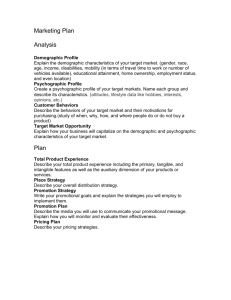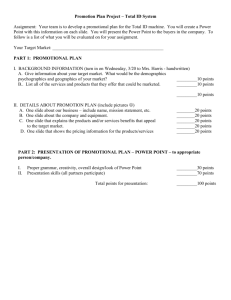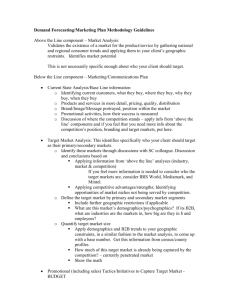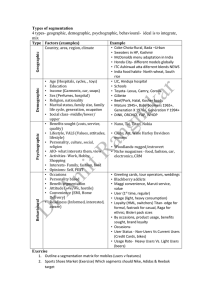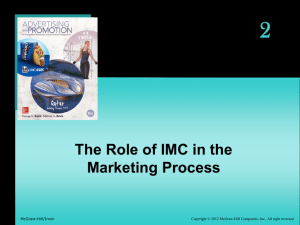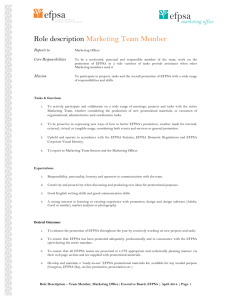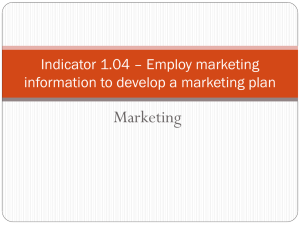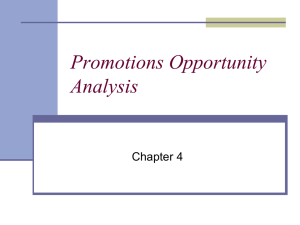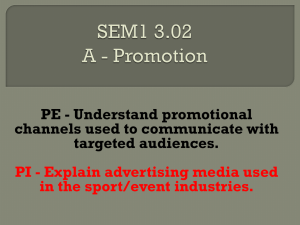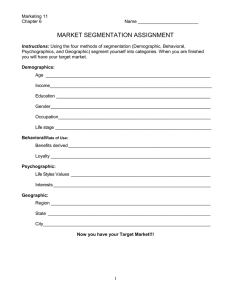How To Identify A Target Market And Prepare A Customer Profile
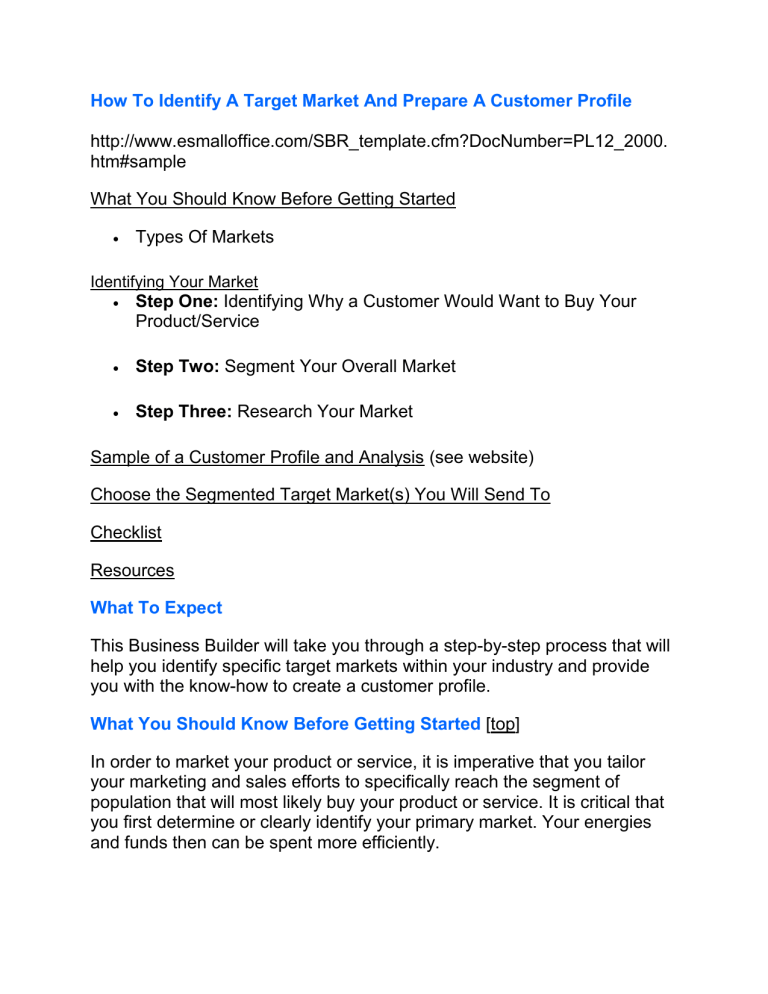
How To Identify A Target Market And Prepare A Customer Profile http://www.esmalloffice.com/SBR_template.cfm?DocNumber=PL12_2000.
htm#sample
What You Should Know Before Getting Started
Types Of Markets
Identifying Your Market
Step One: Identifying Why a Customer Would Want to Buy Your
Product/Service
Step Two: Segment Your Overall Market
Step Three: Research Your Market
Sample of a Customer Profile and Analysis (see website)
Choose the Segmented Target Market(s) You Will Send To
Checklist
Resources
What To Expect
This Business Builder will take you through a step-by-step process that will help you identify specific target markets within your industry and provide you with the know-how to create a customer profile.
What You Should Know Before Getting Started [top]
In order to market your product or service, it is imperative that you tailor your marketing and sales efforts to specifically reach the segment of population that will most likely buy your product or service. It is critical that you first determine or clearly identify your primary market. Your energies and funds then can be spent more efficiently.
If you don't know who your customers are, how will you be able to assess whether you are meeting their needs? Since success depends on your being able to meet customers' needs and desires, you must know who your customers are, what they want, where they live and what they can afford.
We've all heard a business owner say, "My product is terrific! It appeals to everyone." Many of us have also seen small businesses that try to be all things to all people. This is a difficult, if not impossible, bridge to cross.
Targeting your market is simply defining who your primary customer will be.
The market should be measurable, sufficiently large and reachable.
For Example, a printer's target of mid-sized firms with mid-size projects is not a measurable definition. However, a target market of firms within a radius of 20 miles, with annual revenues of $10 to $25 million and a need for four-color printing runs of approximately 5,000 pieces is a clear definition.
Once your target market is defined through your knowledge of product appeals and market analysis, and can be measured, you should determine whether that target market is large enough to sustain your business on an ongoing basis. In addition, your target market needs to be reachable. There must be ways of talking to your target audience.
Based on the information above: Define the target market for the following items.
** This is your first definition. We will research and create a more precise one later**
Xbox Kinect:
Myford touch:
Let’s get started!
Types Of Markets
A market is simply any group of actual or potential buyers of a product.
There are three major types of markets. o The consumer market . Individuals and households who buy goods for their own use or benefit are part of the consumer market. Drug and grocery items are the most common types of consumer products. o The industrial market . Individuals, groups or organizations that purchase your product or service for direct use in producing other products or for use in their day-to-day operations. o Ex. Office furniture and computer systems o Selling services to a business: accounting & legal services, waste removal, security o The reseller market . Middlemen or intermediaries, such as wholesalers and retailers, who buy finished goods and resell them for a profit.
Identifying Your Market [top]
Here are three steps to follow when identifying your market:
1.
Identify Why A Customer Would Want To Buy Your Product/Service
The first step in identifying your target market is understanding what your products/services have to offer to a group of people or businesses . To do this, identify your product or service's features and benefits. A feature is a characteristic of a product/service that automatically comes with it.
For example, if a toothpaste has a stain-removing formula, that's a feature. The benefit to the customer, however, is whiter teeth.
2.
3.
While features are valuable and can certainly enhance your product, benefits motivate people to buy.
An Example is anti-lock brakes; they are features on a car, but the
benefit to the consumer is safety.
By knowing what your product/service has to offer and what will make customers buy, you can begin to identify common characteristics of your potential market.
For example, there are many different consumers who desire safety as a benefit when purchasing a car. Rather than targeting everyone in their promotional strategy, a car manufacturer may opt to target a specific group of consumers with similar characteristics, such as families with young children. This is an example of market segmentation.
Now it’s your turn. Choose a product and decide why a customer would want to buy it.
2.
Segment Your Overall Market o It is a natural instinct to want to target as many people and groups as possible. However, by doing this your promotional strategy will never talk specifically to any one group, and you will most likely turn many potential customers off. Your promotional budget will be much more cost effective if you promote to one type of customer and speak directly to them. This allows you to create a highly focused campaign that will directly meet the needs and desires of a specific group.
Again, this is called market segmentation. o Case Study A president of a management training firm had been marketing to Fortune 500 companies more than a year. She received some business, but the competition was fierce. One day, she received a call from the owner of a manufacturing plant who needed to have managers trained.
The president agreed to take the job, and found out there was virtually no competition for plant manufacturing training services, because it was less glamorous to train in a manufacturing plant than in executive offices of the
Fortune 500 companies. The president decided to change her marketing strategy and target only manufacturing plants. Their promotional material reflected this change. Within six months the company increased its revenues by 80 percent and created a competitive edge by segmenting its market. o Market segmentation is the process of breaking down a larger target market into smaller segments with specific characteristics. Each group requires different promotional strategies and marketing mixes because each group has different wants and needs. Segmentation will help you customize a product/service or other parts of a marketing mix, such as advertising, to reach and meet the specific needs of a narrowly defined customer group. o Geographic Decide if your business is going to do business on a local, regional, national or international level. Identify the geographic region where your market is located. Identify specific boundaries within which you will do business.
Choose a business that would sell your product. What is the geographic market? o Demographic.
Potential customers are identified by criteria such as age, race, religion, gender, income level, family size, occupation, education level and marital status. Choose those characteristics of your demographic target market that relates to the interest, need and ability of the customer to purchase your product or service.
For example, a target market for a real estate developer selling luxury vacation homes near Walt Disney World would include professional married couples approximately 30 to 45 years old with young children, and with incomes of more than $100,000.
Consumer Market:
Age _______________________________
Income ____________________________
Gender ____________________________
Profession _________________________
Education__________________________
Family size ________________________
Marital status ______________________
Psychographic.
Many businesses offer products based on the attitudes, beliefs and emotions of their target market. The desire for status, enhanced appearance and more money are examples of psychographic variables. They are the factors that influence your customers' purchasing decision. A seller of luxury items would appeal to an individual's desire for status symbols.
Business customers, as well as consumers, can be described in psychographic terms. Some companies view themselves as cutting edge or high tech, while others consider themselves socially responsible, stable and strong. Still others see themselves as innovative and creative. These distinctions help in determining how your company is positioned and how you can use the company's position as a marketing tactic.
For Example: Southwest Airlines has positioned itself as an innovative and fun airline that takes passengers on short, inexpensive excursions, whereas Delta chooses to promote reliability and safety.
Consumer Market
Lifestyle ________________________________________
Fun-seeking _____________________________________
Family Stage _____________________________________
Hobbies _________________________________________
Sports Enthusiasts ________________________________
Socially Responsible ______________________________
3.
Research Your Market
